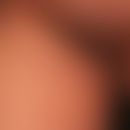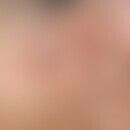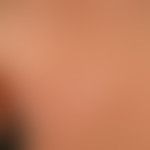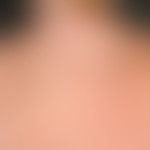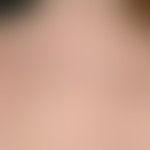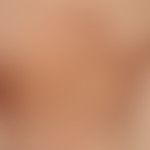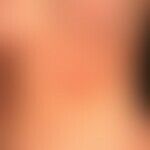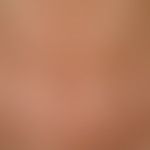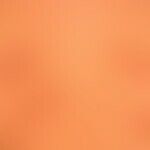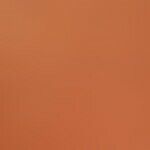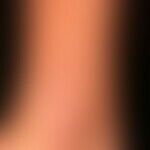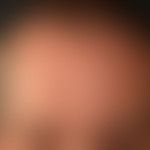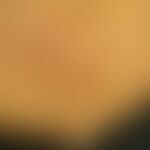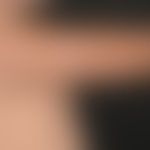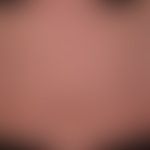Synonym(s)
HistoryThis section has been translated automatically.
Thieial 1845; Gintrac 1847;
DefinitionThis section has been translated automatically.
Heterogeneous group of chronic, relapsing, sclerosing connective tissue diseases of the skin which, depending on the subtype and localization, show different involvement of structures close to the skin such as fatty tissue, muscles, joints and bones. Involvement of internal organs such as the heart, lungs, kidneys or gastrointestinal tract is an absolute rarity in circumscribed scleroderma; a transition to systemic scleroderma does not occur.
The classic form (morphea or plaque type) is generally characterized initially by a blurred, delimited, delicately saturated redness that expands centrifugally and gradually fades centrally. This is followed by the formation of a plate-like, waxy to board-hard induration with a surrounding, inflammatory rim(lilac ring), which indicates further inflammatory progression. The course of the plaque type of circumscribed scleroderma (morphea) is heterogeneous with remissions within 2 years, but also longer-term persistence, in around 15% of patients even after 10 years. Overall, the disease is characterized by a variable course with remissions and relapses. If several foci of the disease are present at the same time, different stages of development of the lesions can occur. Developmental stages of the lesions can also coexist.
A clinical (and probably also pathogenetic) peculiarity is the linear/band-shaped variants. Usually beginning in early childhood, they can lead to cutaneous-subcutaneous-osseous atrophy on the capillitium (en coup de sabre, Parry-Romberg syndrome) with orbital or even orodental involvement, and to severe osseous and muscular growth disorders on the extremities, depending on their severity (these cases should be treated with immunosuppressive therapy at an early stage).
You might also be interested in
ClassificationThis section has been translated automatically.
Depending on the shape, size and location of the sclerotic hardening of the connective tissue, a distinction is made between 3 clinical types and various special forms:
Type I Plaque-like circumscribed scleroderma (ZS) with variants (approx. 70% of adults and approx. 30% of children):
- Variants:
- Plaque or morphea type also limited form of ZS (about 60% of the total ZS collective)
- generalized form of circumscribed scleroderma (maximum variant of the plaque or morphea type)
- bullous, circumscribed scleroderma (bullous variant of the plaque type)
- small-spotted, circumscribed scleroderma (guttate type)
- unilateral, circumscribed scleroderma
- Atrophizing type(atrophodermia idiopathica et progressiva) (about 20% of the total ZS collective)
Type II Linear/band-shaped circumscribed scleroderma (10-30% of adults and approx. 65% of children):
- Variants:
- Limb type (special form: pansclerotic circumscribed scleroderma, also: disabling pansclerotic morphea as maximum variant of type II) with potential disruption of limb growth
- Sclérodermie en coup de sabre (together with Parry-Romberg syndrome, approx. 14% of children)
- Parry-Romberg syndrome (Hemiatrophia faciei progressiva)
Type III Profound, circumscribed scleroderma (approx. 12% of children):
- Special forms:
- Sclerofascia (deep morphea, morphea profunda)
- eosinophilic fasciitis (Shulman type).
________________________________________
Classification S2k guideline/ Kreuter A et al. (2024)
- Limited form
- Morphea (plaque type)
- Morphea guttata (special form of morphea)
- Atrophodermia Pierini-Pasini (special form of morphea)
- Deep form of morphea (deep morphea)Generalized form of circumscribed scleroderma
- Generalized form
- Generalized circumscribed scleroderma (involvement of at least 3 anatomical areas)
- Disabling pansclerotic morphea (severe special form)
- Linear form of circumscribed scleroderma
- Linear circumscribed scleroderma (mostly affecting the extremities)
- Linear circumscribed scleroderma of the "en coup de sabre" type
- Progressive facial hemiatrophy (Parry-Romberg syndrome)
- Eosinophilic fasciitis (special form with leading involvement of the fascia)
- Mixed form
- Expression of several subtypes (e.g. plaque type with linear type or generalized type)
Occurrence/EpidemiologyThis section has been translated automatically.
The incidence in the overall population is 2/100,000, with similar incidences in children and adolescents. The disease occurs predominantly in whites (85%), 5% in blacks and 3% in Asians.
Studies with genome-wide association have been conducted on large multinational patient cohorts. In a US study, the relative risk of inheriting localized scleroderma was < 2% compared to < 0.1% in the general population. 10-30% of patients reported a family history of autoimmune disease (Torok KS et al.2019).
EtiopathogenesisThis section has been translated automatically.
Insights into the pathogenesis of morphea are often extrapolated from studies of systemic sclerosis, as the histopathologic features of the skin are similar; however, clinically they are two distinct diseases that differ in demographics, clinical features, disease course and prognosis. Regarding their pathogenesis, genetic (correlation with HLA-B8, DR1, DR5), immunologic, autoimmunologic, hormonal, viral, bacterial, toxic, traumatic, drug, neurogenic or vascular factors are discussed. Radiation-induced morphea is interpreted as a rare complication of radiotherapy (radiation recall) (Spalek M et al. 2015). Linear circumscribed scleroderma can occur in rare cases as a complicative side effect of TNF-alpha antagonist therapy.
-
Genetics: The candidate gene for inheritance susceptibility is expected to have single nucleotide polymorphisms (SNPs). The dominant region associated with localized scleroderma is a major histocompatibility complex. HLA class I and class II alleles are associated with the development of localized scleroderma, although in familial cases there is no common HLA haplotype in affected individuals in different families. Within families, patients with morphea have at least one HLA haplotype in common, while other family members with identical HLA haplotypes did not develop the disease. The role of the genetic factor has been supported by cytogenetic evidence of chromosomal breaks as a result of an abnormal DNA repair process.
In addition to trauma, infections and genetic factors, embryonic disorders are also suspected as causes of linear CS, including an epigenetic mosaic constellation (see below mosaic, cutaneous). Cutaneous mosaic patterns can also be detected in the plaque type of circumscribed scleroderma.
- Infections: Especially in young patients, Borrelia infections can initiate a circumscribed scleroderma (Borrelia associated early-onset morphea/Borrelia-specific antigens such as OspA or OspC have a high antigenic potential and can initiate autoreactive processes). See Borrelia below.
- Autoimmunological components: There is a growing consensus that an autoimmunological component is pathogenetically relevant (autoimmunological and rheumatic diseases in the family, concomitant rheumatic or autoimmunological diseases, ANA +).
- Molecular causes: Smad proteins appear to play a role in fibrosis processes at the molecular level. Studies have shown that the expression of Smad7 mRNA is reduced in clinically affected areas after UVA1 phototherapy. Furthermore, antimicrobial peptides and proinflammatory cytokines such as IL-6 and IL-8 appear to play a pathogenetic role. IL-6 mRNA, IL-8 mRNA and ß-defensin mRNA were decreased in clinically affected areas after UVA1 phototherapy, similar to Smad proteins.
ManifestationThis section has been translated automatically.
Manifestation peak: 1st-4th decade of life; the subtypes of circumscribed scleroderma and the extracutaneous associations differ in adults and children. Circumscribed superficial (plaque-type) and generalized morphea are common in adult-onset circumscribed scleroderma, whereas linear scleroderma, both linear subtypes on the trunk/extremities and linear subtypes on the head, are more common in childhood-onset circumscribed scleroderma.
LocalizationThis section has been translated automatically.
Mainly the trunk (58%), lower extremities (24%), upper extremities (12%) or head (6%) are affected. Mucosal changes are rarely present. The perimammillary and genitoanal regions are characteristically omitted. If the female breast is affected, the areolar parts remain free. They can bulge out like hernias if the surrounding area is affected.
Alveolysis may occur in cases of circumscribed scelroderma in the area of the oral mucosa or the gums. In most cases involving the oral mucosa, this is a topical continuation of cutaneous scleroderma. The same can be found in the female genital area. Circumscribed scelroderma on the penile mucosa has been described. However, a reliable differentiation from lichen sclerosus et atrophicus may be difficult.
The absence of lesions at sites where apocrine glands are located is conspicuous. Occasionally, muscles (myosclerosis - or muscle atrophy) and fasciae are affected.
The occurrence of circumscribed scleroderma in old vaccination scars, on postoperative scars, at sites of a healed zoster infection (see also under isotopic response), impetigo contagiosa, tinea corporis or over varicosis has already been described in older literature (cited in Korting GW 1958).
ClinicThis section has been translated automatically.
Different variants are observed in type I circumscribed scleroderma (limited form):
- Classic plaque or morphea type: Mostly painless, chronically stationary or progressive, localized on the trunk and extremities, varying in size (0.5-30.0 cm or larger), roundish or oval, also confluent over a large area, centrifugally expanding, sharply defined, white, red or brown flat indurations. In the center of the indurations, a white or yellow, hard plate is often formed, which is caked to the base and in which the follicular structure is missing (destruction of the hair follicles). These plate-like indurations are often surrounded by a ring-shaped, blue-violet to lilac-colored erythema border = lilac ring (sign of progression). The lesions of circumscribed scleroderma can be roundish to oval, also structured like a map. Cutaneous mosaic formations (e.g. checkerboard pattern - see Fig.), which indicate postsomatic mutations in as yet unknown genes, have also been detected.
- Atrophodermia idiopathica et progressiva is a primary atrophizing variant of the plaque type with large, barely indurated, red-brown or red, slightly sunken atrophic areas.
- The guttata form (also known as the confetti type) of circumscribed scleroderma(morphea guttata) usually shows disseminated, rump accentuated yellowish-whitish, superficially shiny, slightly indurated patches, papules or plaques barely 1 cm in size. Initially, pale red spots may appear.
- According to the AWF guideline, the"generalized form of circumscribed scleroderma" is present if at least three anatomical localizations are affected. The trunk, thighs and the lumbosacral region are preferentially affected. The plaques often occur symmetrically and can confluent to form larger areas, in which case they are associated with movement disorders. The very rare"disabling pansclerotic morphea", which is classified as the maximum variant of generalized CS, is extremely severe (see illustration). The combination of linear and disseminated large areas with only a slight tendency to regression of the fibrosis often leads to contractures and wound healing disorders even in childhood.
Type II of circumscribed scleroderma(linear or banded circumscribed scleroderma):
- Strip-like or band-like or systematized indurations with a longitudinal course (segmental alignment? Blaschko lines?). Localization: mainly found on the extremities (band-like circumscribed scleroderma) or on the capillitium (frequently on the forehead: scleroderma en coup de sabre). These can heal as mild forms with hyperpigmentation. More common, however, are coarse sclerotic streaks that extend over joints and lead to restricted mobility. Linear circumscribed scleroderma of the "en coup de sabre" type is usually found frontoparietally, mostly paramedian from the eyebrows to the hairy scalp (lesional alopecia). Focal involvement of the CNS must be ruled out. A variant of linear circumscribed scleroderma is progressive facial hemiatrophy(hemiatrophia faciei progressiva).
Type III of circ umscribed scleroderma:
- Profound circumscribed scleroderma(deep morphea) is the rarest subtype of circumscribed scleroderma (<5% of patients). In this case, plate-like or nodular indurations can be palpated in the subcutaneous fatty tissue and the adjacent fascia ( sclerofascia, eosinophilic fasciitis). The overlying skin can be displaced uninvolved over the induration. The changes occasionally manifest symmetrically, preferably on the extremities. It can occur as early as childhood and can sometimes manifest itself without a preceding inflammatory reaction.
In a review of adults (see also scleroderma, circumscribed juvenile), extracutaneous manifestations were observed in about 20% of cases, although these (apart from skeletal and muscular changes in the linear forms) play no clinical role:
- Skeletal (25-44%): Polyarthritis, osteoporosis.
- Gastrointestinal tract (approx. 12%): Dysphagia, gastroesophageal reflux, diarrhea, constipation.
- Genital tract: 38% of patients suffer from lichen sclerosus et atrophicans.
- Lungs (7%): Fibrosis (dyspnea on exertion and at rest), cough, cyanosis.
- Muscle: myopathy (weakness), pain.
- Heart: arrhythmia, heart failure, pericardial effusion.
- Kidney: proteinuria, insufficiency, hypertension.
- Liver: primary biliary cirrhosis
- Neurological symptoms: MS (7-10 times higher risk compared to the normal population).
Autoimmunological comorbidities: systemic lupus erythematosus (58-fold increased risk compared to the normal population); vitiligo (3.5-fold increased risk compared to the normal population; psoriasis vulgaris (1.4-5-fold increased risk compared to the normal population).
LaboratoryThis section has been translated automatically.
Antinuclear antibodies: The data are (fluctuating depending on literature and type). 30-70% of patients are positive for antinuclear antibodies (ANA), the anti-topoisomerase II-alpha antibody (76%) is also detectable, as is the anti-single-stranded DNA antibody (with a wide distribution between 4% and 60% depending on the test). This could be an indication of systemic inflammatory activity. Importantly, the antibodies do not correlate with clinical activity and severity, with the exception of linear/banded circumscribed skelroderma.
Recent prospective studies of serum cytokines in circumscribed scleroderma have identified potential blood markers of disease activity, including CXCL9 (Torok KS et al. 2019/s.a. CXCL9 gene). However, the value of these markers is unclear; they are not yet widely available in clinical practice.
HistologyThis section has been translated automatically.
Inflammatory stage: Dense inflammatory infiltrate, mainly of lymphocytes. Edematous swelling of the collagen fiber bundles. Septal panniculitis in the upper parts of the fatty tissue with sparse or also nodular round cell infiltrates, also eosinophils and plasma cells at the dermo-subcutaneous border. Rare formation of germinal centers. Enclosure of fatty tissue lobules by collagenous bundles.
Sclerotic stage: widespread proliferation of dermal connective tissue at the expense of subcutaneous adipose tissue. Homogenized, widened collagen fibre bundles run parallel to the skin surface. Atrophic adnexa, slit-shaped constricted vessels. Walled-in eccrine sweat glands. Rather sparse perivascular and diffuse lymphocytic infiltrates. Nodular compaction of the infiltrates at the border to the subcutis. Broad, homogenized and also edematized fatty tissue septa with sparse round cell infiltrates.
DiagnosisThis section has been translated automatically.
Characteristic clinical picture. The histological examination is diagnostic but rarely conclusive.
Differential diagnosisThis section has been translated automatically.
Early inflammatory phase of limited ZS (morphea)
- Lichen sclerosus
- Vitiligo (important differentiation when the genitoanal region is affected; histology is diagnostic here)
- Erythema chronicum migrans
- Cutaneous mastocytosis
- Granuloma anulare
- Radiation dermatitis(radiation-induced morphea)
- Mycosis fungoides
- Drug reactions
Late stage of limited ZS (morphea) with leading hyperpigmentation.
- Post-inflammatory hyperpigmentation
- Lichen planus actinicus
- Café-au-Lait spots
- Erythema dyschromicum perstans
Late stage of limited ZS (morphea) with leading atrophy
- Acrodermatitis chronica atrophicans
- Lipodystrophy
- Lichen sclerosus: (important DD for small-spotted circumscribed scleroderma; histology is helpful but not always conclusive; in contrast to lichen sclerosus et atrophicus, circumscribed scleroderma never affects the mucous membranes of the genitalia)
- Scars
- Radiation-induced "morphea"
- Necrobiosis lipoidica (histology is diagnostic in connection with the clinical findings).
Generalized ZS
- Systemic scleroderma (ANA and organ involvement are absent in circumscribed scleroderma)
- Pseudoscleroderma
- Scleroderma adultorum Buschke
- Scleromyxedema
- Sclerodermiform graft-versus-host disease
- mixed collagenosis
- nephrogenic systemic fibrosis (leading symptoms: renal insufficiency, rapid progression, gadolinium application during MRI examinations).
Linear ZS of the coup de sabre type
- panniculitis
- progressive partial lipodystrophy
- focal dermal hypoplasia
- steroid atrophy
- Lupus erythematosus profundus
Complication(s)(associated diseasesThis section has been translated automatically.
Although circumscribed scleroderma does not usually present with internal organ manifestations such as interstitial lung disease or cardiac arrhythmias, the underlying lesional tissue compartments are frequently affected in this clientele, leading to morbidity. The frequency of extracutaneous involvement in circumscribed scleroderma varies in the literature between 20 and 70 %, depending on whether the data were collected retrospectively or prospectively, with prospective assessment data capturing more manifestations.
- Skeletal system: The most common extracutaneous manifestations across all cohorts are musculoskeletal manifestations, including arthralgias, arthritis, joint contractures, myositis and fasciitis associated with disease-related gait disturbances, functional impairment, muscle, bone and limb atrophy, followed by neurologic, ophthalmologic and dental problems, which occur in approximately 50% of patients with circumscribed scleroderma with head involvement.
- Neurological complications: These manifestations include seizures, headaches, hemiparesis, cranial nerve palsy, optic neuritis, uveitis, scleritis, dry eye, atrophic dental roots, crowding of teeth and malocclusion.
- Autoimmunological associations: association with other autoimmunological and rheumatological diseases, in particular psoriasis vulgaris, systemic lupus erythematosus, multiple sclerosis and vitiligo. Parry-Romberg syndrome can be associated with Rassmussen's encephalitis. It is characterized by unilateral cerebral involvement. Associations with genital lichen sclerosus have been described.
TherapyThis section has been translated automatically.
Physiotherapy: Lymphatic drainage, massage, physiotherapy are helpful. Particularly in linear, multi-joint forms, joint mobility must be maintained through physical therapy.
Biomechanical stimulation (BMS ) supports the promotion of blood circulation and deep massage with loosening of the tissue.
Severe clinical pictures that occur across joints, are rapidly progressive or with multiple foci in visible areas should be treated systemically, whereby the general consensus is that MTX is most effective.
In localized manifestations, topical corticosteroids and calcineurin inhibitors are also possible as an alternative to or in combination with UV phototherapy.
General therapyThis section has been translated automatically.
Avoidance of local pressure and injuries (e.g. tight waistband, pressing shoes on the back of the foot). Permanent pressure can lead to the formation of new foci in existing scleroderma.
Physiotherapy: Studies on the efficacy of physiotherapy in circumscritic scleroderma do not exist for various reasons. Reasons not. Nevertheless, the measures are an important accompanying component in the multimodal treatment of the disease and are frequently used in clinical practice.
- In particular, cross-joint linear circumstrictive scleroderma should be treated with physiotherapy.
- Connective tissue massage and manual lymphatic drainage can be performed in the sclerotic stage concomitantly to system therapy or following system therapy (1-2x/ week for 3-6 months).
- Physiotherapy and muscle building are mandatory in the linear subtype of the extremities.
External therapyThis section has been translated automatically.
Glucocorticoids: Especially for plaque type in an active phase, topical steroids are effective. Duration of therapy: about 3 months, apply medium- to high-potency topical steroids 1-2x/day strictly lesionally.
Intralesional glucocorticoid applications are usually performed only in the rare linear subtype en coup de sabre in the active marginal area. Triamcinolone acetonide 10-40 mg diluted with lidocaine 1:2 - 1:4 is most commonly injected intralesionally.
Vitamin D 3 -analogues ( calcipotriol or tacalcitol) can produce a tissue-softening effect. Creams and lotions containing urea (Eucerin Urea Lotion, Lipoderm Urea) or evening primrose seed oil (Eucerin Omega 12% Lotion, Lipoderm Omega) are suitable for the care of dry, vulnerable skin.
Topical calcineurin inhibitors: Small pilot studies and case reports describe the successful use of tacrolimus 0.1% under occlusion in morphea. The efficacy of this therapeutic approach is not adequately established.
Imiquimod: Few case series and some case reports exist. After 3-6 months of therapy a significant improvement of dyspigmentation, sclerosis and erythema was described. The efficacy of this therapeutic approach is not sufficiently proven.
Radiation therapyThis section has been translated automatically.
Consistent irradiation with UVA1 in an ascending dosage is recommended, starting with 5 J/cm² up to 20 J/cm². The inflammatory component can thus be controlled after only 10-15 treatments. If sclerosis has already occurred, UVA1 irradiation should be maintained at the above dose until the tissue has softened. In addition to the anti-inflammatory effect, UVA1 irradiation results in the release of collagenase with corresponding softening of collagenous connective tissue.
In adulthood, high-dose UVA1 therapy can be performed, taking into account the side effects. This may also regress sclerosis and hypopigmentation.
In a controlled study of phototherapy for circumskripten scleroderma, UVA1 was shown to be significantly more effective than narrow band UVB phototherapy.
Internal therapyThis section has been translated automatically.
In the linear subtype with facial involvement or joint involvement, or compromise of length growth, therapy with methotrexate in combination with systemic glucocorticoid pulse therapy should be used early (prednisolone 1.0 g i.v. for 3 days/ 6-month therapy regimen).
In generalized circumscritical scleroderma, high-dose protocols with steroid pulse therapy (1.0 g prednisolone/day i.v. for 3 days) in combination with MTX continuous therapy (15 mg/week MTX p.o.) have been used with good success. With this variant, therapy should also be started as early as possible.
Encouraging results have been achieved with low-dose methotrexate (mono) therapy (15 mg/week MTX p.o. over a period of 24 weeks).
In the meantime, the previously frequently used systemic therapy with penicillin G 10 mega IU/day i.v. for 10 days (3 cycles at intervals of 4 weeks) has been largely abandoned. Exception: V.a. in the presence of a Borrelia infection.
D-Penicillamine: International literature still claims a certain value (personal experience is negative in this respect).
Operative therapieThis section has been translated automatically.
In case of sclerotic growth disorders, dermatogenous contracture, scarring alopecia, timely surgical intervention is indicated.
In the facial region, a specialized center of oral and maxillofacial surgery should be consulted, and in the case of involvement of the joints and extremities, a specialized pediatric surgeon or orthopedist should be consulted.
Progression/forecastThis section has been translated automatically.
Generally active course over several years, after which the disease burns out, leaving the resulting sclerosis or atrophy.
25% of patients suffer a recurrence, which can occur even after years of latency. The linear form has a particularly high recurrence rate.
Indications of increased disease activity and a higher relapse rate are an early occurrence of circumscribed scleroderma and ANA positivity.
NaturopathyThis section has been translated automatically.
Note(s)This section has been translated automatically.
In Anglo-American literature, the term morphea is increasingly used instead of circumscritic scleroderma.
Of note in a familial LEMD3 mutation is the case description of osteopoikilosis(Buschke-Ollendorf syndrome) associated with late-onset localized morphea-type scleroderma (Korman B et al 2016). DNA sequencing of this case revealed a previously undescribed nonsense mutation (Trp621X) in the LEMD3 gene encoding Man1.
S.a. Newsletter: Juvenile Circumscribed Scleroderma.
LiteratureThis section has been translated automatically.
- AWF Guideline (2008) Diagnosis and treatment of circumscribed scleroderma. Register number 013 - 066 Classification S1
- Gelber AC, Wigley FM (2002) Disease severity as a predictor of outcome in scleroderma. Lancet 359: 277-279
- Ghoreschi K, Rocken M (2002) Phototherapy of sclerosing skin diseases. Dermatology 205: 219-220
- Hercogova J (2002) Borrelia burgdorferi: a protagonist in Lyme disease, a bystander in morphoea? J Eur Acad Dermatol Venereol 16: 98-99
- Khatri S et al (2019) Autoantibodies in Morphea: An Update. Front Immunol 10:1487.
- Korman B et al. (2016) Mutation in LEMD3 (Man1) Associated with Osteopoikilosis and Late-Onset Generalized Morphea: A New Buschke-Ollendorf Syndrome Variant. Case Rep Dermatol Med. 2016:2483041.
- Kortin GW (1958) Scleroderma and scleroderma-like diseases. In: Gottron-Schönfeld Dermatology and Venereology Vol II2 p.897
- Kreuter A et al. (2006) Ultraviolet A1 phototherapy decreases inhibitory SMAD7 gene expression in localized scleroderma. Arch Dermatol Res 298: 265-272
- Kreuter A et al. (2006) Ultraviolet A1-induced downregulation of human beta-defensins and interleukin-6 and interleukin-8 correlates with clinical improvement in localized scleroderma. Br J Dermatol155: 600-607
- Kreuter A et al. (2006) A randomized controlled study of low-dose UVA1, medium-dose UVA1, and narrowband UVB phototherapy in the treatment of localized scleroderma. J Am Acad Dermatol 54: 440-407
- Kreuter A et al. (2005) Pulsed high-dose corticosteroids combined with low-dose methotrexate in severe localized scleroderma. Arch Dermatol 141: 847-852
- Kreuter A et alk. (2024) S2k guideline: Diagnosis and therapy of localized scleroderma. J Dtsch Dermatol Ges 22: 605-620.
- Leitenberger J et al.(2009) Distinct autoimmune syndromes in morphea. Arch Dermatol 145: 545-550
- Lutz V et al. (2011) High frequency of general lichen sclerosus in a prospective series of 76 patients with morphea. Arch Dermatol 2011: 305
- Marzano AV et al. (2003) Localized scleroderma in adults and children. Clinical and laboratory investigations on 239 cases. Eur J Dermatol 13: 171-17
- Mertens JS et al.(2015) Disease recurrence in localized scleroderma: a retrospective analysis of 344 patients with paediatric- or adult-onset disease. Br J Dermatol 172:722-728
- Nagai Y et al (2002) Unilateral generalized morphea in childhood. J Dermatol 29: 435-438
Noh TW et al. (2011) Morphea developing at the site of healed herpes zoster. Ann Dermatol 23:242-245.
- Seyger M et al. (1998) Low-dose methotrexate in the treatment of widespread morphea. J Am Acad Dermatol 39: 220-225
- Sehgal VN et al (2002) Localized scleroderma/morphea. Int J Dermatol 41: 467-475
- Spalek M et al (2015) Radiation-induced morphea - a literature review. J Eur Acad Dermatol Venereol 29:197-202.
- Stücker M et al. (1999) Severe course of mutating pansclerotic circumscript scleroderma in childhood. Dermatology 50: 131-135
- Toledano C et al. (2008) Localized scleroderma: a series of 52 patients. Eur J Intern Med 20:331-336
- Torok KS et al (2019) Immunopathogenesis of Pediatric Localized Scleroderma. Front Immunol 10:908.
- Uziel Y et al. (2000) Methotrexate and corticosteroid therapy for pediatric localized scleroderma. J Pediatr 136: 91-95
- Weibel L et al. (2006) Evaluation of methotrexate and corticosteroids for the treatment of localized scleroderma (morphea) in children. Br J Dermatol 155: 1013-1020
- Yazdanpanah MJ et al.(2015) Frequency of Borrelia in Morphea Lesion by Polymerase Chain Reaction in Northeastof Iran.Jundishapur J Microbiol 8:e19730
- Zulian F et al. (2005) Localized scleroderma in childhood is not just a skin disease. Arthritis&Rheumatism 52: 2873-2881
Incoming links (55)
Anetoderma; Anular lipoatrophia; Atrophodermia idiopathica et progressiva; Atrophodermia linearis; Biomechanical stimulation; Buschke-ollendorf syndrome; Coup de sabre; Dermatitis-arthritis syndromes; Dermatoliposclerosis; Dermatosclerosis; ... Show allOutgoing links (36)
antimicrobial peptides ; Atrophodermia idiopathica et progressiva; Biomechanical stimulation; Borrelia burgdorferi sensu lato; Buschke-ollendorf syndrome; Calcineurin inhibitors; Calcipotriol; CXCL9; CXCL9 gene; Cytokines; ... Show allDisclaimer
Please ask your physician for a reliable diagnosis. This website is only meant as a reference.
Images (96)
Articlecontent
- History
- Definition
- Classification
- Occurrence/Epidemiology
- Etiopathogenesis
- Manifestation
- Localization
- Clinic
- Laboratory
- Histology
- Diagnosis
- Differential diagnosis
- Complication(s)(associated diseases
- Therapy
- General therapy
- External therapy
- Radiation therapy
- Internal therapy
- Operative therapie
- Progression/forecast
- Naturopathy
- Note(s)
- Literature
- References
- Authors
